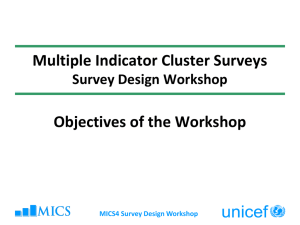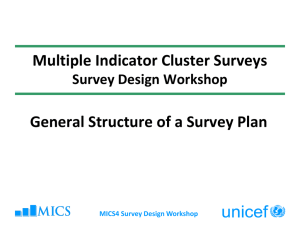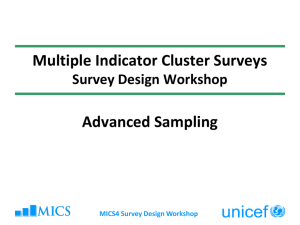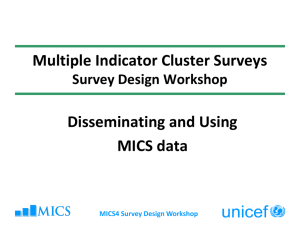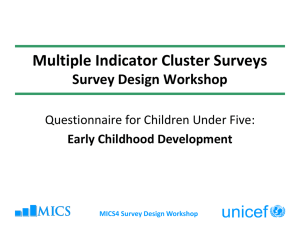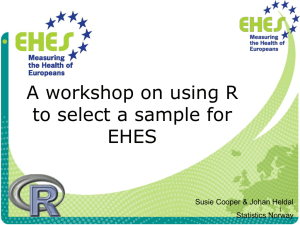Sampling Overview
advertisement
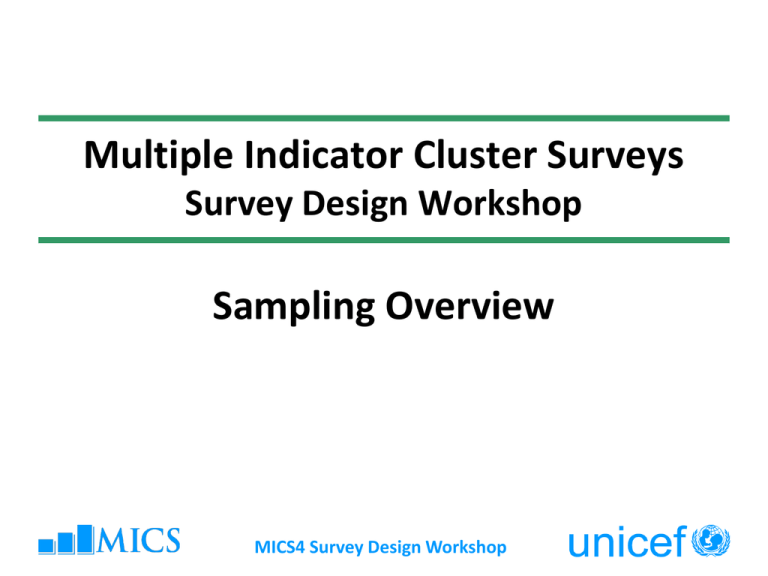
Multiple Indicator Cluster Surveys Survey Design Workshop Sampling Overview MICS4 Survey Design Workshop Introduction • MICS is multi-national survey program – Consistency and comparability between surveys is important • MICS based on national stratified multi-stage sample • Workshop session covers highlights of MICS sampling, including: – Identifying effective sampling frame and sample design – Determinants and calculation of sample size MICS4 Survey Design Workshop Importance of correct sampling procedures • Sample design will affect inferences of survey results • Coverage of frame and appropriate probability sampling are critical • Accuracy of survey results depends on both sampling and non-sampling errors MICS4 Survey Design Workshop Key concepts in proper sampling • Use accepted probability techniques at every stage of selection • Use of simple sampling methodology • Use the latest census as the sampling frame when available • Sampling in two stages • Use of clusters of moderate size • Use of an adequate sample size MICS4 Survey Design Workshop MICS4 prototype sample design • Manual presents different sampling options • All options involve two or three-stage cluster sampling – Primary sampling units (PSUs) – census enumeration areas – Listing in sample clusters or use of compact clusters – Sample households selected from listing • Option for each country depends on type of frame and availability of existing samples MICS4 Survey Design Workshop Sampling option 1 – use existing sample • Most cost-effective approach • Determine whether existing sample is appropriate – Probability sample • Known probabilities of selection at each stage – Nationally representative – Sufficient number of sample PSUs for MICS – Example – 2008 Mozambique MICS3 MICS4 Survey Design Workshop Sampling option 1 – continued • Determine when listing of households in sample EAs was conducted – Listing can be used if less than 1 year old – Generally select new sample of households from listing – Possible to use selected households from other survey • Consider response burden, analytical needs for both surveys • Conduct new listing in existing sample or subsample of EAs • Availability of master sampling frame in some countries MICS4 Survey Design Workshop Sampling option 2 – standard segment design • Based on standard segments of about 500 persons or 100 households • Effective procedure when some EAs are too large for listing • Three-stage sample design • Measure of size for each EA – calculated number of segments • EAs selected systematically with PPS • Larger sample EAs with 2 or more segments subdivided • One segment selected in each EA for listing, enumeration MICS4 Survey Design Workshop Sampling option 3 – modified segment design • Three-stage sample design • Small compact clusters with about 20-30 households • Measure of size of EAs – calculated number of compact clusters • EAs selected systematically with PPS • Mapping and segmentation in all sample EAs • One compact cluster selected in each sample EA for listing, enumeration MICS4 Survey Design Workshop Relationship of sampling with other aspects of survey planning • Survey budget – may determine maximum sample size • Sampling plan should also take into account required timing of MICS results • Estimate costs and time related to PSUs – transportation, listing • Costs related to sample households – cost of interviewing (days of enumeration) MICS4 Survey Design Workshop Sampling and fieldwork organization • Effective balance of number of sample PSUs and cluster size • Dispersion of sample affects transportation costs, travel time • Size of team of enumerators and supervisor • Interviewer workload MICS4 Survey Design Workshop Factors that affect sample size • • • • • Budget and resource constraints Timing and logistical considerations Select key indicators Required level of precision Need for sub-national estimates – Regions, provinces, urban/rural domains MICS4 Survey Design Workshop Selecting key indicators • Person variables (rates) • Important indicator that will yield the largest sample size • Estimated rates between 15 and 20% • Target population that comprises a small proportion of the total population – Children aged 12 to 23 months MICS4 Survey Design Workshop Sample size determinants – sampling parameters • Level of precision – standard error, coefficient of variation (CV) • Acceptable level of error - margin of error, relative margin of error • Level of confidence – 95% • Design effect (DEFF) – depends mostly on level of clustering in the sample • Average household size • Proportion of base population in total population • Adjustment for non-response MICS4 Survey Design Workshop Use of previous MICS or DHS results • Review sample design of previous survey • Examine sample size and allocation to geographic domains • Study level of precision for key indicators – Design effects – 95% confidence intervals • Results can be used to determine sample size and allocation for new MICS MICS4 Survey Design Workshop Formula for sample size calculation • Two similar spreadsheet templates for MICS4 – Entry cell for each sampling parameter – Formula for calculating required number of sample households • Presentation and discussion of spreadsheets MICS4 Survey Design Workshop Sample Size Formula n 4r (1 r )( deff )(1.1) _ 2 (. 12 r ) ( p)( n) where – n is the required sample size, expressed as number of households, for the KEY indicator – 4 is factor to achieve 95 percent level of confidence, – r is anticipated prevalence rate for key indicator, – 1.1 is factor to raise sample size by 10 percent for potential nonresponse, – deff is shortened symbol for design effect, – 0.12r is margin of error to be tolerated, defined as 12 percent of r (12 percent thus represents the relative margin of error), – p_ is proportion of total population that smallest group comprises, and – n is average household size. MICS4 Survey Design Workshop Sample size reference table • Table 4.3 in Chapter 4 of MICS manual • Can be used for specific set of parameters: – – – – – Target population is 2.5% of total population DEFF = 1.5 Nonresponse rate is 10% Relative margin of error is 12% 95% level of confidence MICS4 Survey Design Workshop Sample Size (Households) to Estimate Coverage Rates for Smallest Target Population Average Household Size (number of persons) 4.0 4.5 5.0 5.5 6.0 estimated rate, r = 0.25 estimated rate, r = 0.30 estimated rate, r = 0.35 estimated rate, r = 0.40 13,750 12,222 11,000 10,000 9,167 10,694 9,506 8,556 7,778 7,130 8,512 7,566 6,810 6,191 5,675 6,875 6,111 5,500 5,000 4,583 Use this table when your 1. Target population is 2.5% of total population; this is generally children 12-23 months old 2. Sample design effect, deff, is assumed to be 1.5 and nonresponse is expected to be 10 percent 3. Relative margin of error is set at 12 percent of estimate of coverage rate, r MICS4 Survey Design Workshop Number of PSUs and cluster size • More PSUs and smaller clusters – Statistically more efficient – greater dispersion of sample – More costly – transportation, listing • Minimum number of PSUs - 300 to 400 at national level – Minimum of 30 PSUs for subnational domains • Number of sample households per cluster generally in range of 15 to 30 households MICS4 Survey Design Workshop
